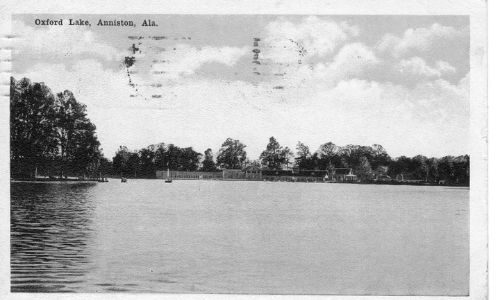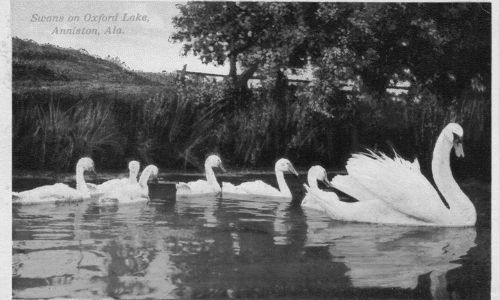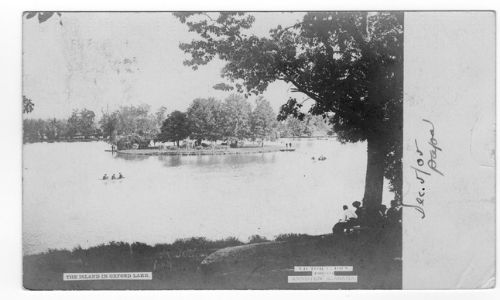
October 12, 2021
Kimberly O’Dell
Summer Resorts have always been popular in the United States. What most fail to realize is that Calhoun County, Alabama had its own summer resorts in the early days. Benton County, later Calhoun, was founded in 1832 and the area was blessed with many natural water sources. The Native American tribes, mainly Muskogee Creek, would spend summers around the natural springs and lakes in the area. When the settlers arrived, they adopted the same customs. One of the early “resorts” was John Schenck’s Sulphur Springs just north of Jacksonville. Schenck kept the springs at his own expense from the 1850s until the 1870s. Schenck’s Springs had only picnic areas and swimming facilities. Amusements would come to Calhoun County before the end of the 19th Century.
The best known of the summer resorts in the county was Oxford Lake Park. Early settler Barnett McCulley of Alexandria purchased the Springs near Oxford for his family home around 1832. By the late 1880s, the McCulley homestead was sold to Minnie Lula Lake Company. Oxford Lake Park, a vacation and recreation area on the old McCulley farm, was created at the end of the Oxford Lake Trolley Line in 1889. The Anniston Inn built in 1885 was a Queen Anne style resort hotel that was conveniently located near the Oxford Lake Line.
 The Victorian Era saw amusement parks created at the end of trolley lines to entice people to ride the street cars and Oxford Lake was no different. While the trolleys operated, generally on the hour and half hour up to 11:00 PM, attendance was good. The Oxford Lake Line left Anniston near the Anniston Inn hotel and took the rider to the end of the line at Oxford Lake.
The Victorian Era saw amusement parks created at the end of trolley lines to entice people to ride the street cars and Oxford Lake was no different. While the trolleys operated, generally on the hour and half hour up to 11:00 PM, attendance was good. The Oxford Lake Line left Anniston near the Anniston Inn hotel and took the rider to the end of the line at Oxford Lake.
The early days of Oxford Lake Park had boat rides on the lake with picnics and dancing on the shore. Fishing for brim off the pier was a popular pastime especially for young boys. Street car parties, where street cars were rented for a private group, were popular on the Oxford Lake Line and were frequently reported in the society pages of the local newspaper. In Victorian times, boat rides were 25¢ and when time was up a gong summered riders back to the boathouse. The Park had a dancing pavilion and a swimming pool with bathhouses. The swimming pool had a sliding door to prevent male patrons from seeing the female patrons in their bathing clothes.
Amusements at the lake changed through the decades. By 1915, amusements had vastly increased to include a horse racing track complete with grandstand and stables. The Park also had an opera house that hosted top-rated traveling entertainment troupes. In addition, there was a small zoo, carousel, 6-lane bowling alley, restaurant, and band stand. The Oxford Lake Line maintained a waiting room at the entrance to the park. Vaudeville shows were a popular activity at the lake. Many World War I soldiers stationed at Camp McClellan brought their sweethearts to the lake for a day of fun. But eventually the boardwalk gave way to a midway and the horse racing track became an automobile racing track.
Oxford Lake Park was a popular destination for families and young people in the county. The main problem with the park was instability in ownership during its early times. Because the trolley line owned the property, the land was transferred several times until the Anniston Electric Company became the proprietor at the turn of the 20th Century. This would not be the last time the property would change hands but by the 1940s the property was leased to mangers.
The Great Depression of the 1930s took its toll on Oxford Lake Park. The trolley system ended by 1932 and replaced by the Crescent bus service. Many of the surrounding cities had built swimming pools for their citizens. The only amusement ride left was the carousel. People had few reasons to come to the park. But the U.S. entry into World War II changed Oxford Lake’s fate. In the early 1940s, the Morgan family leased the park. They brought in traveling amusements and set up a permanent home at Oxford Lake. The family retained the zoo, swimming pool, bowling alley, and boat rides on the lake. The Morgans also widened the walkway around the lake. Just as they did during World War I, soldiers from now Fort McClellan came by bus and private automobile to enjoy leisure time at the lake. The Morgans also brought in special event promotions to tempt visitors and by far the most popular events were boat races.
Post-War America faced a  recession and Calhoun County was no exception. By the mid-1950s, the Morgans ended the lease and sold off their amusements and attractions. The park’s future was uncertain until the city of Oxford purchased the park in 1960. The direction of the park changed once the city took over operation. Gone were the zoo and boat rides, but the swimming pool, pavilions, and pier remained. The original boathouse was eventually enclosed as a picnic area and remained at the lake until the late 1970s. The wooden dancing pavilion was destroyed by fire in the mid-1960s, and the bowling alley met a similar fate a few years later. A civic center was constructed and a subdivision of post war houses was built across the street from the park.
recession and Calhoun County was no exception. By the mid-1950s, the Morgans ended the lease and sold off their amusements and attractions. The park’s future was uncertain until the city of Oxford purchased the park in 1960. The direction of the park changed once the city took over operation. Gone were the zoo and boat rides, but the swimming pool, pavilions, and pier remained. The original boathouse was eventually enclosed as a picnic area and remained at the lake until the late 1970s. The wooden dancing pavilion was destroyed by fire in the mid-1960s, and the bowling alley met a similar fate a few years later. A civic center was constructed and a subdivision of post war houses was built across the street from the park.
In the 1990s, the park became almost unrecognizable with a civic center, swimming pool, golf course, baseball/softball complex, and picnic areas. Today, there are some additional features including the Coldwater Creek Bridge and a new pier. One thing that has not changed is the 4th of July Fireworks. As early as 1892, the citizens of Calhoun County headed to Oxford Lake to enjoy the picnic areas and a night of fireworks.
To view more photographs of Oxford Lake through the years see Images of America: Calhoun County (1998) by Kimberly O’Dell.
Sources:
The Anniston Star
The Jacksonville Republican
The Wetumpka Times Democrat
 Kimberly O’Dell is a local historian based in Calhoun County, Alabama. She is the author of Calhoun County (1998), Anniston (2000) and Anniston Revisited (2015) part of the Arcadia Publishing Images of America Series. Website: http://kimberlyodellauthor.wixsite.com/kimberlyodellauthor
Kimberly O’Dell is a local historian based in Calhoun County, Alabama. She is the author of Calhoun County (1998), Anniston (2000) and Anniston Revisited (2015) part of the Arcadia Publishing Images of America Series. Website: http://kimberlyodellauthor.wixsite.com/kimberlyodellauthor

Advertisement





